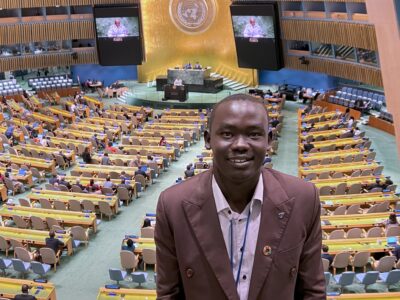
As I entered my classroom, world flags were hung from the walls and our professor pounded a gavel. It was time for our mock UN climate change negotiations.
Although our class, Environmental Policy and Governance, focuses on domestic environmental politics in the US, that day we were learning about global environmentalism. Our professor, the Climate School’s own Lisa Dale, was one of Columbia University’s delegates to the United Nations’ 27th Conference of the Parties (COP27) in Sharm El-Sheik, Egypt. The conference convenes global leaders to spur climate action. She designed this class activity to help us understand the global conversations on climate change that were occurring at COP27 and at large.
The activity was simple. Professor Dale assigned us roles representing the United States, the European Union, China, India and some developing countries. In addition, a few of us had special roles as a climate activist, a fossil fuel industry lobbyist, and a Green Climate Fund representative. We each had two main goals. The first was to serve the interests of our country or special interest group, and the second was to collectively limit global warming to 1.5 degrees Celsius. Professor Dale had us all introduce ourselves, gave us 20 minutes to negotiate, and then tallied up our emissions reductions to see if we had achieved the 1.5 degrees Celsius goal. As we would all find out, the activity proved more complex than we had anticipated. It forced us to think from global perspectives.

While we all wanted to see 1.5 degrees Celsius easily achieved, we could not just wave a magic wand. We had to represent our constituencies first, and as a result, 1.5 degrees Celsius became a much more difficult target. The students representing the United States, European Union, and China were quick to defend their countries’ reliance on fossil fuels. The students representing India and other developing countries questioned why they should reduce emissions at all when the developed world was responsible for most of the world’s carbon emissions. These developing nations also suggested that they ought to be able to increase carbon emissions as they pursue a higher standard of living. Furthermore the developing nations who will be hardest hit by climate change sought financial compensation from the high-emitting developed nations. Contributions to the United Nations’ Green Climate Fund helped with this, but did not fully solve the problem.
As the activity progressed, we refined our negotiation strategies by appealing to the interests of each participant. The climate activist argued that more and more refugees will seek asylum in the United States and European Union under current warming scenarios, and that climate action was really in their self interest. The Green Climate Fund advocate used a similar argument, saying that contributions to the Green Climate Fund now will finance the needed adaptation to ameliorate such refugee crises. The European Union, looking to reduce its emissions, agreed to further finance the Green Climate Fund if the contributions preserved forest and counted as carbon offsets.

When the activity ended, we plugged in the numbers to a global warming calculator, and we came within the ballpark of 2.0 degrees Celsius. We were all disappointed, but we now understood why 1.5 degree Celsius is a challenging global goal. By negotiating with our different constituencies, we gained a more global perspective on the climate crisis. We walked away less quick to point fingers and more likely to listen.
The Columbia Climate School aims to “educate future leaders for just and prosperous societies on a healthy planet.” In order to think on that planet-wide basis, we need global perspectives to be integrated into that education. Activities such as a mock UN climate negotiation are good examples of effective educational tools, and I encourage educators to use similar strategies. If emerging climate leaders can think globally and act locally, I have the hope that we can solve the climate crisis.
Rex Koenig is an undergraduate majoring in Sustainable Development at Columbia University.
Views and opinions expressed here are those of the authors, and do not necessarily reflect the official position of the Columbia Climate School, Earth Institute or Columbia University.



